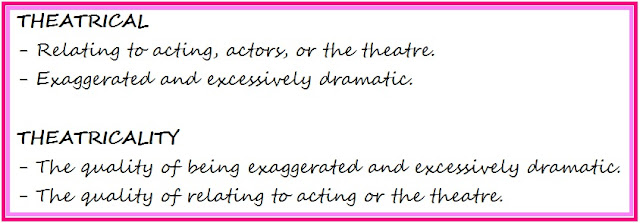Thinking Theatricality
It is interesting that in the Oxford English
Dictionary definition of the two terms, Theatricality emphasises the more
negative association of the term, rather than the aesthetic connotation.
Theatricality, as a notion, relates to lies and falsehood, all the way back to
Plato’s suspicion of mimesis. Even Nicholas Ridout writes that there is ‘an
antitheatrical prejudice within the discipline of theatre studies itself.’[1] And
Stanislavski urged his students to ‘act simply and naturally, without
theatricality.’[2] But even to ‘act naturally’
in a theatre production is still theatrical as the self of the character is not
the self of the actor. They are not-not-I[3],
which is a theatrical device.
While both Theatricality and Performativity are fluid
terms and resistant to a singular definition, I found clarity in the writing of
Josette Féral who writes that ‘Theatricality seems to be a process that has to
do with a “gaze”…’[4] that semiotically reads
the space, recognises the ‘other’ and allows theatricality to takes place in
the gap between the self and other. It is a result of either a body (the other/an
etic view) claiming the space as a theatrical space, and/or a spectator (the self/an
emic view) framing a performance or performative as a theatrical event. This
imposition on the performer, the other, can happen willingly, as in the case of
an actor acting, or unwillingly, as in when the spectator impose a theatrical
narrative on an event or action.
Our attempt at coming up with some definitions or explanations of Theatricality
Theatricality is, therefore, found in the space of
spectatorship: when an action or performance is deliberately interpreted as
removed from the quotidian.
Image Source: autoevolution.com
Davis and Postelwait posit that ‘Theatricality is […]
a way of describing what performers and spectators do together…’[5] Theatricality
is a relationship – a spectatorship. Does this mean that theatre, and
theatricality is ‘more true’ because it relies on this bearing witness?
Theatricality is, at least, a conscious choice imposed on a body (emic or
etic), aware of its falsehood, aware of its own performance, rather than
performativity which appears to be, in part, unconscious.
Reinelt writes of ‘theatre’s capacity for creating
a new real, making manifest the real, embodying the real…[and]… Theatrical
tools can be useful for decoding social reality…’[6] which
reflects Victor Turner’s cultural feedback loop. Theatricality provides us with
a model for performativity, and theatre can provide us with a blueprint for
social action.
Image Source: fandbnews.com
Writing of rituals, the display of emotion at grand
events, parades, etc. Reinelt states that ‘It seems clear that the public life’s
theatricalization is no longer a contested issue’.[7] We
prize theatricality over ‘reality’, the falsehood over the truth, and
entertainment over evidence. However, Ridout writes that ‘In becoming aware of
this framing up we are invited to see what lies not outside the frame but
beneath or within it…’[8] Theatricality
is an awareness of falsehood, which invites us to look for the truth beneath
it. Only by framing the theatre as separate, as ‘other’, can we recognise what
is outside it, and recognise the ‘self’.
[1] Nicholas
Ridout, ‘Introduction’, in Stage Fright,
Animals, and Other Theatrical Problems (Cambridge and New York: Cambridge
University Press, 2006), p.15.
[2]
Stanislavski, quoted in Tracy C. Davis and Thomas Postlewait, ‘Theatricality:
An Introduction’, in Theatricality,
ed. by Davis and Postlewait (Cambridge and New York: Cambridge University
Press, 2003), p.21.
[3][3]
Richard Schechner, ‘Restoration of Behaviour’, in Between Theater and Anthropology (Philadelphia: University of
Pennsylvania Press, 1985), p.112.
[4]
Josette Féral
and Ronald P. Bermingham, ‘Theatricality: The Specificity of Theatrical
Language’, SubStance, 31.2-3 (2002),
p.97.
[5] Tracy
C. Davis and Thomas Postlewait, ‘Theatricality: An Introduction’, in Theatricality, ed. by Davis and Postlewait
(Cambridge and New York: Cambridge University Press, 2003), p.23.
[6]
Janelle Reinelt, ‘Towards a Poetics of Theatre ad Public Events in the Case of
Stephen Lawrence,’ TDR: The Drama Review,
50.3 (Autumn 2006), pp.71-83.
[7] Ibid.,
p.71.
[8] Nicholas
Ridout, ‘Introduction’, in Stage Fright,
Animals, and Other Theatrical Problems (Cambridge and New York: Cambridge
University Press, 2006), p.13.







Comments
Post a Comment